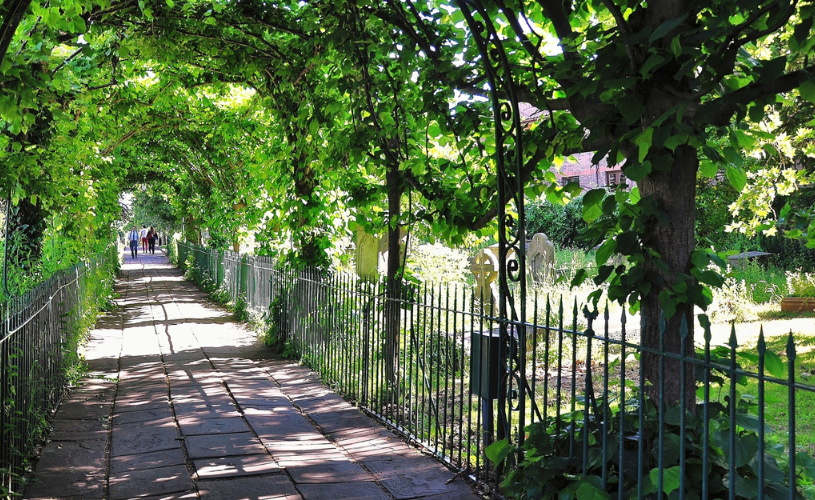Bristol-based author Charlie Revelle-Smith offers an insight into the unusual inspiration that led him to write the first installment of his Bristol Mysteries series.
A graveyard may not be the first place to come to mind when imagining a perfect day out in the city, in fact, admitting that you’d rather spend a day surrounded by the long departed than just about anything else is likely to be met with a narrowing of the eyes and suspicious sideways glances. What kind of morbid curiosity could draw anyone to a place built for the dead?
For my fellow graveyard enthusiasts, the answers are clear and numerous. Far from macabre, burial grounds can prove to be beautiful, peaceful and above all else, life affirming. Graveyards and cemeteries are among the largest green spaces within our city and owing to the respect offered to their sanctity, often remain untouched by time. As an escape from the bustle of city life, graveyards have a near mystical ability to transport the visitor to a haven of tranquility – an island of quiet in an urban ocean that attracts a range and variety of wildlife that many people have no idea live right on their doorsteps.
I have drawn up a short list of some of the most fascinating historic graveyards and cemeteries in Bristol, each of which is unique in its own way – some well known and some less so, which have helped inspire me and are well worth exploring for anyone who wants a more unusual day out in the city.

Image - Arnos Vale Cemetery
Arnos Vale Cemetery
The grandfather of Bristol’s burial grounds, Arnos Vale is not only the best known of all resting places in the city but also the most beautiful.
Established in 1837, the cemetery fell into disrepair throughout the 20th century, but thanks to a concerted effort on behalf of a band of determined volunteers and a large grant from the Heritage Lottery Fund, Arnos Vale has been saved from ruin.
Whilst the most opulent of graves and mausoleums are close to the cemetery entrance gate (including the grandiose and much visited resting place of Indian social reformer Raja Rammohun Roy,) I would recommend following one of the smaller paths into the woodlands which have sprung up among the tombstones. There you will find a vast, sprawling necropolis of staggering melancholic beauty.

Image - Grave of Raja Rammohun Roy at Arnos Vale Cemetery
Birdcage Walk
This small, incredibly quiet graveyard in Clifton Village is one of the lesser known burial sites in the city. Taking its name from the verdant arches that line the walkway across the graveyard, this is all that remains of St. Andrews Church – built in the 12th century but destroyed in the Bristol Blitz. Birdcage Walk is a uniquely tranquil place to while away an afternoon.
It may not at first be clear that the graveyard is even accessible, but at either end and at the midway point there are gates welcoming you inside. Here you will find quiet benches under the shade of ancient trees, including a stunning yew, which may be one of the largest in the whole city.

Image - Birdcage Walk in Clifton
The Quaker Burial Ground
One of our most central burial grounds is also one of its least apparent. In fact, standing in the centre of it, one would struggle to realise it even was such a place.
Stepping into what remains of the graveyard in Redcliffe, it is a near miracle how quickly the constant drone of the traffic outside of St Mary Redcliffe church is lost to a respectful silence.
From the early 18th to the mid 19th centuries, this piece of land belonged to the Bristol chapter of the Society of Friends as their burial ground. Quakers have prided themselves on a history of radical ideas – and though some of their members in Bristol had profited greatly from the slave trade, they were among the first religious organisations to publicly oppose it; they were also early adopters of cremation and as such, by the mid 20th century it was seen by them as an extravagance to hold onto space in an area that was desperately in need of urban renewal, resulting in them gifting it to the council and leading the way for road expansion.
Little remains to remind visitors of the importance this location once held, save for one stark remnant. Towards the back of the small park there is a chamber built into the red stone cliff that was sculpted to house a hermit who would pray continuously for the wealthiest Quakers of the city. Now it is home to the moving sight of hundreds and hundreds of gravestones piled one upon another as a testament to the sheer number of people buried there.

Image - St Mary Redcliffe Church
Greenbank Cemetery
Established in 1871, Greenbank Cemetery is among the oldest large burial grounds in the city. Hidden away just off of Stapleton road in East Bristol, Greenbank is similar in scale and grandeur to Arnos Vale Cemetery, with a welcoming avenue of trees leading visitors through the oldest headstones – many of which have been beautifully preserved to a degree that hides just how long ago they were erected. These are the headstones one imagines when thinking of the majesty of cemeteries – ornate sculptures of angels and elaborate monuments that make it an especially atmospheric destination in the early evening.
Most poignant of all, however is what is to be found to the north – a tremendously moving memorial to the war dead of Bristol involved in conflicts throughout the world, as well as those lost in the Bristol Blitz, including entire families devastated in a single night. It is an almost unbearably sad reminder of the enormous losses our proud city has confronted in the past, and all the more startling when contrasted with the tranquility and beauty of the cemetery.
For more information on Charlie Revelle-Smith's books you can visit his website or follow Weird Bristol.
Read more:





